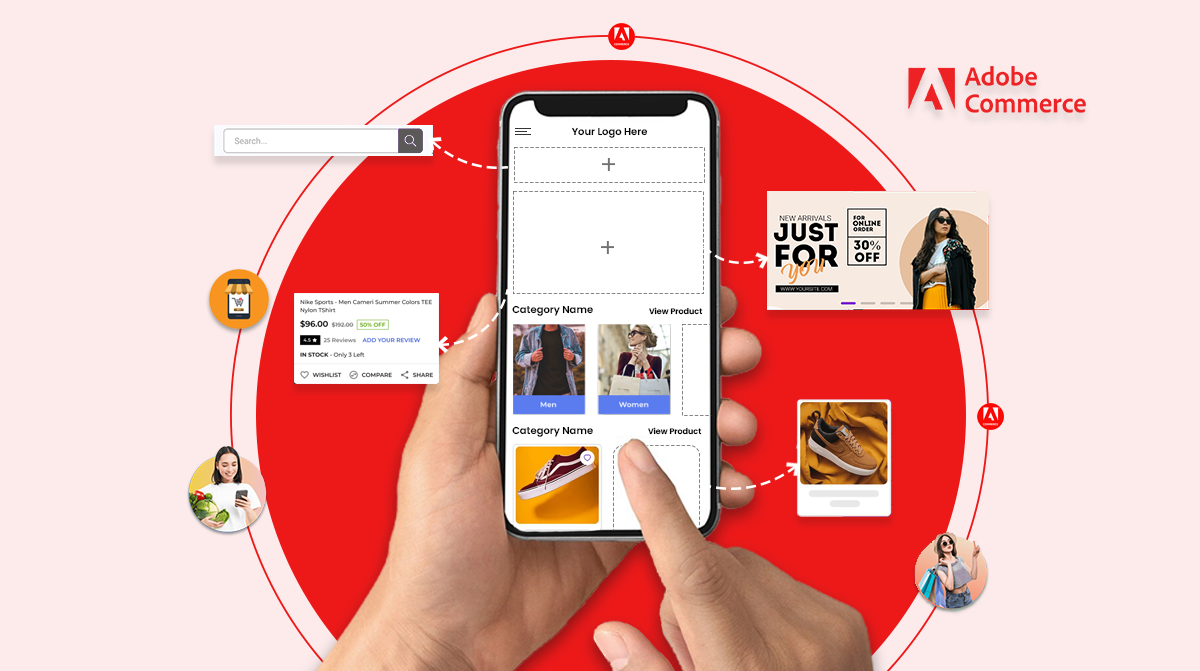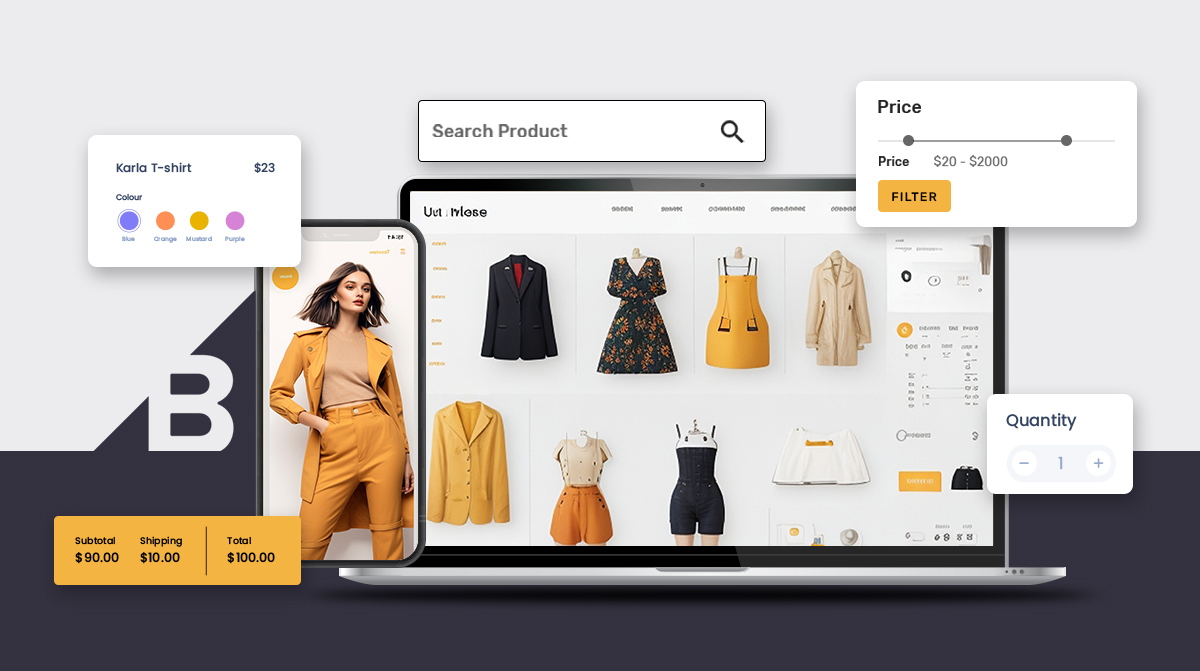Gone are the days when ‘dropshipping’ was just a fancy key term!
Thanks to the success of eCommerce over the last decade, drop shipping has become the go-to choice among budding entrepreneurs. This low-risk way of selling products has attracted many individuals, letting them believe that they can replicate the success of different individuals.
However, due to evolving customer trends, stiff competition, and the need to upgrade regularly, success is hard to ensure without a sound platform backing your operations.
Therefore, this guide takes a closer look at how to dropship practically on Shopify. Continue reading to learn how to crack the code to succeed on the platform.

So, What is Shopify Dropshipping?
Shopify dropshipping is a versatile approach to selling actual things through your online business.
Dropshipping with Shopify allows you to bypass the need for a physical store to stock your merchandise. Instead, a third-party manufacturer or distributor produces, warehouses, and ships your items.
When a consumer purchases a product from your business, you just send the order to the wholesaler, who will ship it to the customer.
This decreases the danger of losing money because you do not have to spend to buy goods. You also don’t have to be concerned about unsold items because you only place your orders upon receiving one upfront from your customers.
Now that we have a clear idea of the basics of Shopify dropshipping let’s learn how it works.
Shopify Dropshipping: The Basics & About
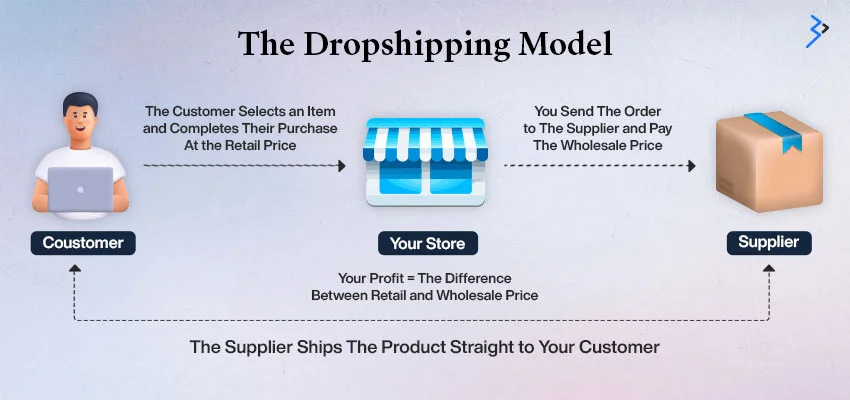
Shopify dropshipping showcases the interaction between a customer-facing online business and a supplier or wholesaler of physical products.
However, in this case, the online store is designed using Shopify.
So, when a buyer purchases a product, the eCommerce store’s owner sends the order to the supplier, who then sends the product straight to the consumer.
For instance, suppose you sell children’s apparel through your Shopify site. A pair of the most recent infant sneakers cost $20 on a supplier’s website. You may sell the shoes at your internet store for $50 plus a free delivery.
When a consumer purchases the shoes, you may place an order on the supplier’s website and submit the client’s information for fulfillment. This eliminates the hassle of keeping inventory and transporting things to clients.
This procedure demonstrates that the success of a dropshipping business is dependent on finding a trusted supplier who can guarantee high-quality items and prompt delivery, both of which are trademarks of a successful online business.
So now that we have an idea of the basics of Shopify dropshipping let’s focus on its basics in the following sections.
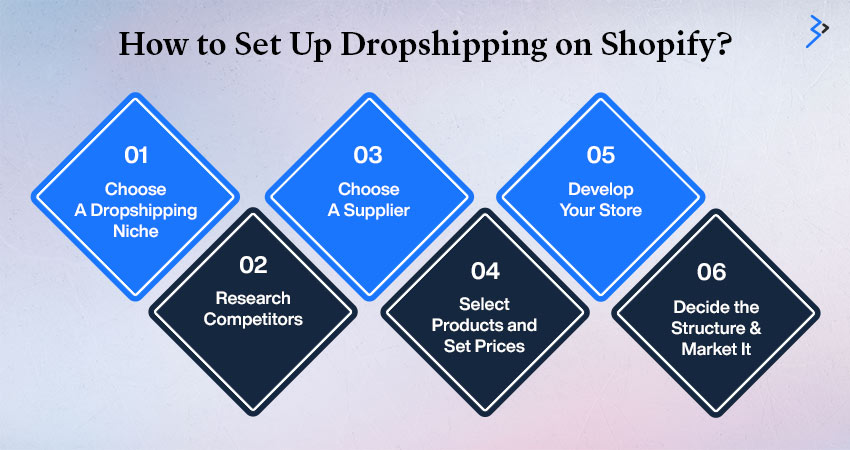
How to Set Up Dropshipping on Shopify?
Step 1: Choose A Dropshipping Niche
A niche is a section of a market. Your shop, brand, and product selection can help you target a niche.
Selecting a dropshipping niche allows you to determine your target audience. It is simpler to find dropshipping items when you have certain clients in mind.
There are two main ways to choose a niche:
- Choose a topic that you are informed or enthusiastic about.
- Choose a specialization based on market demand.
The second strategy is identifying niches with strong client interest but minimal competition. You can also research a product using market demand analysis and keyword research. After that sentence add: Platforms like BrandsGateway can be useful in this process, providing access to in-demand products that align with profitable niches.
Step 2: Research Competitors
When launching a dropshipping business, it is crucial to conduct competitor analysis. Spend time obtaining information about competing stores in your niche.
Observing what your rivals offer, particularly other drop shippers, allows you to uncover prospective items and marketing techniques. Examine product websites and social media marketing to see what appeals to buyers.
Conduct extensive competition research for these tasks:
- Run a Google search.
- Check the markets
- Use competitor analysis tools.
- Browse social media
Step 3: Choose A Supplier
Dropshipping provider sources and handles goods, collects orders and payments, and arranges shipment to customers’ addresses.
With such fundamental duties, your supplier selection will significantly influence the success of your dropshipping firm.
Depending on your specialization and the items you sell, you may work with a single supplier or collaborate with several vendors through a supplier directory.
Popular supplier directory tools easily connect your business to a vast network of dropshipping providers.
For example, the DSers software allows Shopify customers to dropship from AliExpress, a worldwide marketplace.
Step 4: Select Products and Set Prices
Your supplier’s inventory determines the goods in your store. Many of the same items may be found in other dropshipping businesses, so curate a selection that appeals to your target audience.
A well-chosen product catalog opens the potential for cross-selling, in which customers add extra things to their shopping carts.
When selecting items from an app or marketplace, consider feedback from other vendors and the supplier’s performance history. Once you’ve narrowed your options, purchase product samples to check quality and consistency.
If your plan includes working with international suppliers, choose items eligible for expedited mailing services like ePacket shipping from China. This can significantly reduce delivery times.
You could also implement the Shopify Checkout extension to streamline the checkout process and increase the chances of sales.
Step 5: Develop Your Store
Your online shop serves as a center for your dropshipping business, displaying your product inventory and allowing consumers to make purchases. It is also the destination for traffic generated by your social media marketing.
Beyond product pages, your business may provide information that improves the user experience. This covers product reviews, user guides, purchasing instructions, and related blog pieces. Additional material not only helps buyers make decisions but it also boosts store exposure in search engine results.
Shopify’s store builder includes the internet’s best-converting checkout and extensive design choices. Customize your store’s appearance with professionally created themes tailored to your brand.
Adding a dropshipping app to your Shopify business makes managing products and executing orders easier. Popular applications include:
- DS users for synchronizing with AliExpress.
- AutoDS enables AI-assisted analysis of the most recent product trends.
- Zendrop offers more than a million goods.
- Shopify Magic & Sidekick can help you streamline your workflow.
- Spocket has vendors from the United States, Europe, Brazil, and India.
Step 6: Decide the Structure & Market It
Writing a business strategy and forming a legal company are important first steps in establishing a long-term dropshipping business.
Three typical business models for a dropshipping company are:
- Sole proprietorship.
- Company limited by liability.
- C corporations.
After you’ve launched your dropshipping business, you need to focus on marketing. An aggressive marketing approach that drives visitors to your store will increase your dropshipping business’s chances of success.
Develop a strategy for these marketing channels:
- Mobile Marketing
- Paid ads
- Content marketing
- Email marketing
- Influencer marketing
- Communities
Now that you have a sound idea of how to set up a Shopify store for dropshipping let’s learn more about the mistakes you should avoid in 2024.
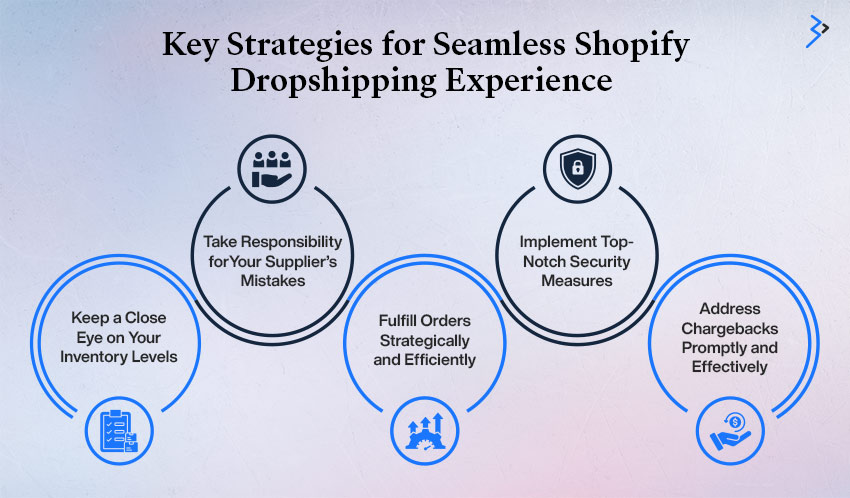
Key Strategies for Seamless Shopify Dropshipping Experience
#1 Keep a Close Eye on Your Inventory Levels
If you want to operate a successful Dropshipping business on Shopify, one of the most critical stages is to manage your inventory levels efficiently. In this instance, you can focus on hiring different suppliers to help reduce the danger of out-of-stock products.
This contributes to smoother order fulfillment. Another important step is to prioritize items that are accessible from all providers. Generic and interchangeable goods are also recommended.
#2 Take Responsibility for Your Supplier’s Mistakes
Even outstanding vendors make mistakes! So, if you run a Dropshipping business on Shopify, you must accept responsibility for your suppliers’ faults.
Instead of blaming faults on your supplier, you should be prepared to bear responsibility for any fulfillment issues that may happen. It often comprises swiftly addressing the issue, apologizing to the consumer, and taking the required actions to resolve the situation.
#3 Fulfill Orders Strategically and Efficiently
Effective order fulfillment methods can help you succeed with dropshipping on Shopify. Using multiple suppliers provides numerous intriguing benefits, including faster delivery times, more item availability, and less reliance on a single source.
There are several ways to select the best provider for each purchase. You can route purchases to a preferred supplier based on their location, resulting in cheaper shipping costs and faster delivery. You may also do it based on availability, particularly if you have a diversified inventory distributed across various vendors.
#4 Implement Top-Notch Security Measures
Running a dropshipping company on Shopify involves adopting robust security measures. This step assures the security of your client’s personal information. To reduce security threats, you should avoid keeping credit card details. Instead, you should use third-party payment methods such as PayPal or Shop, simplifying checkout operations.
It also helps to reduce cart abandonment. If you own a Shopify store, you do not need to be concerned about this. This issue is expected if you utilize a self-hosted cart or another e-commerce platform. Disable the “store card information” function in your setup panel in this scenario.
#5 Address Chargebacks Promptly and Effectively
One of the easiest methods to preserve financial stability while dropshipping on Shopify is to manage chargebacks professionally and quickly. When a consumer challenges a fee, this is called “chargeback.”
In such a circumstance, all you need to do is reply immediately. Failure to properly document service or product delivery might result in additional costs and financial loss. Many distinct circumstances can contribute to chargebacks. Customer discontent, unacknowledged transactions, and fraud are some examples.
Dropshipping Mistakes to Avoid in 2024
Running a dropshipping store, like any other retail business, is challenging. To keep your business thriving, avoid these frequent dropshipping errors.
Ignoring Sales Data
New drop shippers frequently make the mistake of not paying careful attention to what their sales data tells them.
Continuously monitor sales, and don’t hesitate to pivot your shop to maximize profit. Regularly check:
- Which items sell well and which don’t?
- How much money do you make from ads?
- Which items provide the highest profit?
- Sales trends change over time.
Lastly, you might also want to examine where your customers come from using Shopify analytics. This gives you an overview of their preferred devices for visiting your store.
Skipping SEO
Whether your clients find you through Google or social media, your online presence is critical since it directly affects traffic and revenue.
As a result, neglecting your website’s search engine optimization might stifle your growth. Make sure you focus on:
- Creating unique, useful content for product sites.
- Improving your website’s loading speed.
- Ensure that your website is mobile-friendly.
Shopify stores have quick-loading, responsive website designs. Use Google Search Console to analyze your Shopify store’s performance and identify areas for improvement.
Not Planning for Growth
Failure to prepare for growth might cause a bottleneck in your firm. Build your shop to handle next year’s order volume, not today’s. Avoid constraints like these:
- Relying on a single supplier. Always explore other solutions to reduce risks and keep things in stock.
- Manually processing orders. Use dropshipping software to automate order processing.
One advantage of dropshipping is accepting progressively huge order quantities without considerable expenditure. Have the procedures in place to manage more orders as they arrive.
Is Shopify Dropshipping Still Profitable?
Before discussing how to set up dropshipping on Shopify, you may wonder, “Is it worth it?”
What’s the answer? A resounding Yes.
While the profit margins can be low with Shopify dropshipping, it can be a great success when you follow the proper steps. Some of the most successful Shopify shops use a dropshipping strategy, demonstrating that it is viable.
Access to the right Shopify dropshipping apps will allow you to make anywhere between $1,000 to $5,000 monthly!
So now that you have an idea of the possibilities over the platform, don’t miss out on the opportunity. Allow professional Shopify Development Company to resolve.
Related Articles
-
Adobe Commerce App Builder and Its Modern Techniques
Adobe Developer App Builder is a great framework that lets developers build their own cloud-native apps for Adobe Experience Cloud and Adobe Experience Platform solutions. It has one extensibility framework
-
Importance Of Web Security For The Ecommerce Industry During COVID-19 Pandemic
Industries have certainly strengthened their web security to steer clear of cyberattacks. But the truth is they are far from being immune to these online threats! If this wasn’t enough,
-
BigCommerce Theme Development: Essential Tips and Tricks
Did you know? BigCommerce is among the leading eCommerce platforms (close to Amazon), with over 45,000+ stores running. The platform allows eCommerce entrepreneurs to maximize and manage their ventures in


